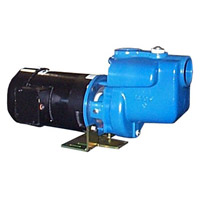Self Priming Centrifugal Pumps for Sale

- Scot - American Marsh - Calpeda
- 1" - 10" Discharge
- 6600 GPM
- 260' TDH
Supplier of Self-Priming Centrifugal Pumps from Leading Manufacturers Scot Pump, AMT & Calpeda
Contact Pump Solutions self-priming centrifugal pump distributors to place an order today!
CONTACT US TODAY For details & pricing!
Self-priming centrifugal pumps are easy to maintain and service because they can be kept above the water line. The term “self-priming” means an air-water mixture can be used to reach a fully-primed pumping condition. They are perfect for use with:
- Dirty water
- Limited solids
- Clear liquids applications
How Self-Priming Centrifugal Pumps Work
1.) During the priming cycle, air enters the pump and mixes with water at the impeller (a spinning, fan-like mechanism creating centrifugal force)
2.) Air and water leave together by the centrifugal force of the impeller
3.) Air-free water flows down the impeller chamber due to gravity
4.) When all of the air has exited, it creates a vacuum in the suction line and pushes water up to the impeller, creating a pumping action
5.) Repeat
Difference Between Self-Priming And Standard Centrifugal Pumps
The main difference between a self-priming centrifugal pump and a standard (non self-priming) centrifugal pump is that a standard pump cannot operate with air in the system. Air is much harder to pump than water (and has different properties). So when air gets into the centrifugal pump, it will become air-bound – non-operational because there is air in a space that is normally filled with liquid.
Standard Centrifugal Pumps
It’s a common misconception that the impeller uses a scooping motion. An easy way to visualize how a standard centrifugal pump works is to imagine a car tire flicking off water on a rainy day. This is centrifugal force and the tire is the impeller.
Different Types of Impellers in Centrifugal Pumps
The impeller is the rotating part of a centrifugal pump designed to move fluids by rotation. Imagine the blades of a fan, and how the angles of them move air in a specified direction. An impeller, by design, moves liquid similar to the way a fan’s blades move air. Although there are different types of impellers, they all use centrifugal force to continuously move liquid into the next stage of the centrifugal pump. The blades of an impeller are referred to as vanes.
The impeller of a Centrifugal Pump can be one of three (3) types, including:
- Open Impeller: The vanes are cast free on both sides
- Semi-Open Impeller: The vanes are free on one side and enclosed on the other
- Closed Impeller: the vanes are located between two discs – all in a single casing. Also referred to as an “enclosed impeller” or a “shrouded impeller”
To order a self-priming centrifugal pump, or to discuss what type of pump is best suited for your specific application, contact the Midwest Pump Distributors at Pump Solutions.
To fully use this site, please enable Javascript








 SHOP PRODUCTS
SHOP PRODUCTS